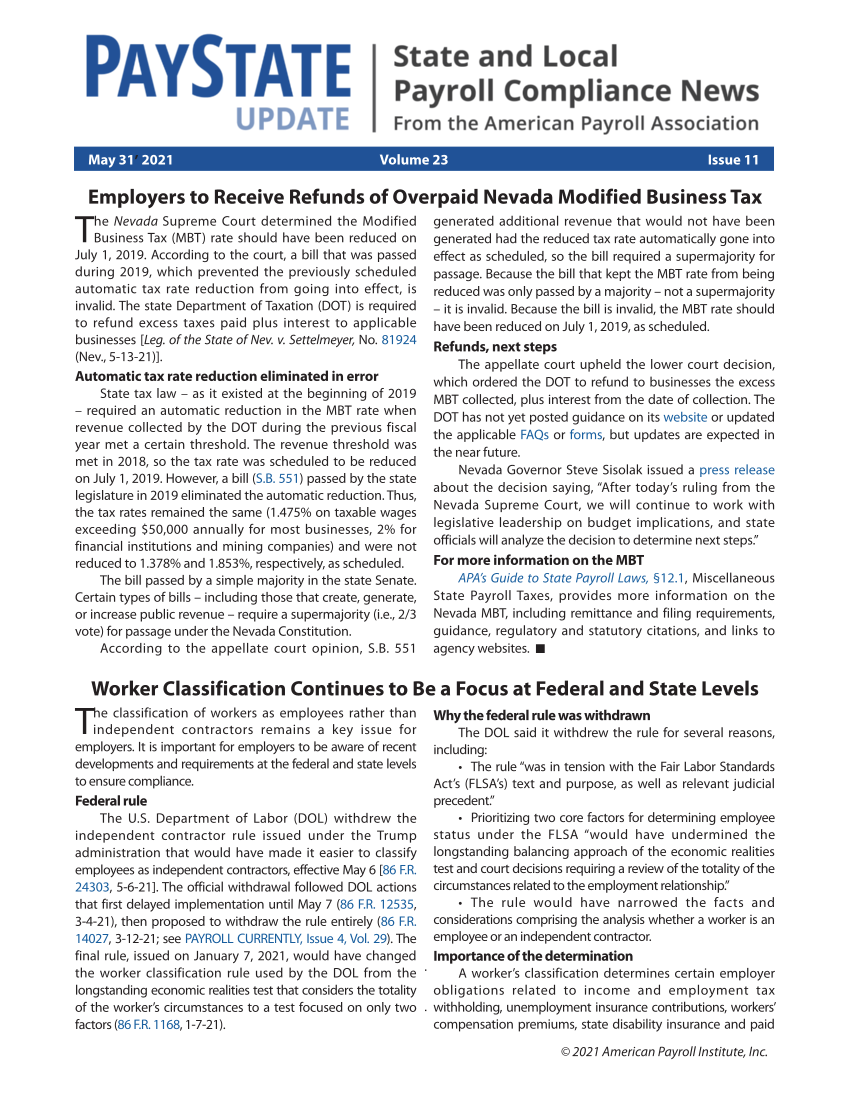© 2021 American Payroll Institute, Inc. Employers to Receive Refunds of Overpaid Nevada Modified Business Tax The Nevada Supreme Court determined the Modified Business Tax (MBT) rate should have been reduced on July 1, 2019. According to the court, a bill that was passed during 2019, which prevented the previously scheduled automatic tax rate reduction from going into effect, is invalid. The state Department of Taxation (DOT) is required to refund excess taxes paid plus interest to applicable businesses [Leg. of the State of Nev. v. Settelmeyer, No. 81924 (Nev., 5-13-21)]. Automatic tax rate reduction eliminated in error State tax law – as it existed at the beginning of 2019 – required an automatic reduction in the MBT rate when revenue collected by the DOT during the previous fiscal year met a certain threshold. The revenue threshold was met in 2018, so the tax rate was scheduled to be reduced on July 1, 2019. However, a bill (S.B. 551) passed by the state legislature in 2019 eliminated the automatic reduction. Thus, the tax rates remained the same (1.475% on taxable wages exceeding $50,000 annually for most businesses, 2% for financial institutions and mining companies) and were not reduced to 1.378% and 1.853%, respectively, as scheduled. The bill passed by a simple majority in the state Senate. Certain types of bills – including those that create, generate, or increase public revenue – require a supermajority (i.e., 2/3 vote) for passage under the Nevada Constitution. According to the appellate court opinion, S.B. 551 generated additional revenue that would not have been generated had the reduced tax rate automatically gone into effect as scheduled, so the bill required a supermajority for passage. Because the bill that kept the MBT rate from being reduced was only passed by a majority – not a supermajority – it is invalid. Because the bill is invalid, the MBT rate should have been reduced on July 1, 2019, as scheduled. Refunds, next steps The appellate court upheld the lower court decision, which ordered the DOT to refund to businesses the excess MBT collected, plus interest from the date of collection. The DOT has not yet posted guidance on its website or updated the applicable FAQs or forms, but updates are expected in the near future. Nevada Governor Steve Sisolak issued a press release about the decision saying, “After today’s ruling from the Nevada Supreme Court, we will continue to work with legislative leadership on budget implications, and state officials will analyze the decision to determine next steps.” For more information on the MBT APA’s Guide to State Payroll Laws, §12.1, Miscellaneous State Payroll Taxes, provides more information on the Nevada MBT, including remittance and filing requirements, guidance, regulatory and statutory citations, and links to agency websites. Worker Classification Continues to Be a Focus at Federal and State Levels The classification of workers as employees rather than independent contractors remains a key issue for employers. It is important for employers to be aware of recent developments and requirements at the federal and state levels to ensure compliance. Federal rule The U.S. Department of Labor (DOL) withdrew the independent contractor rule issued under the Trump administration that would have made it easier to classify employees as independent contractors, effective May 6 [86 F.R. 24303, 5-6-21]. The official withdrawal followed DOL actions that first delayed implementation until May 7 (86 F.R. 12535, 3-4-21), then proposed to withdraw the rule entirely (86 F.R. 14027, 3-12-21 see PAYROLL CURRENTLY, Issue 4, Vol. 29). The final rule, issued on January 7, 2021, would have changed the worker classification rule used by the DOL from the longstanding economic realities test that considers the totality of the worker’s circumstances to a test focused on only two factors (86 F.R. 1168, 1-7-21). Why the federal rule was withdrawn The DOL said it withdrew the rule for several reasons, including: • The rule “was in tension with the Fair Labor Standards Act’s (FLSA’s) text and purpose, as well as relevant judicial precedent.” • Prioritizing two core factors for determining employee status under the FLSA “would have undermined the longstanding balancing approach of the economic realities test and court decisions requiring a review of the totality of the circumstances related to the employment relationship.” • The rule would have narrowed the facts and considerations comprising the analysis whether a worker is an employee or an independent contractor. Importance of the determination A worker’s classification determines certain employer obligations related to income and employment tax withholding, unemployment insurance contributions, workers’ compensation premiums, state disability insurance and paid May 31 , 2021 Volume 23 Issue 11
Printed for: PayrollOrg Bookshelf © 2024 American Payroll Institute, Inc. All Rights reserved. From: PayrollOrg Digital Publications (bookshelf.payroll.org)







